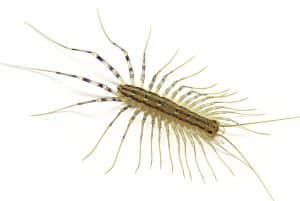Centipedes
Centipedes: the Enemy of My Enemy
House centipedes are objectively horrifying. They’re sneaky- preferring to reside in dark rooms with minimal activity. They’re fast- capable of scuttling across the floor at a top-speed of 1.4 feet per second. Most of all, they’re just genuinely unpleasant to look at, growing up to four inches long end-to-end and sporting up to 15 pairs of those dirty-yellow legs. While they certainly have a deathly appearance and general demeanor, they are actually harmless to humans, and can even provide some benefits to the pest control process.
While certainly not the only species of centipede found in Missouri, the house centipede is most likely the only centipede you’ll ever see in your home. This is because the house centipede has adapted specifically to thrive indoors, a direct result of their vulnerability to winter conditions. When temperatures start dropping, these myriad-legged critters are drawn to the warmth coming from heated structures, at which point they’ll attempt to gain entry to the building via unsealed gaps in entryways like loose-framed doors, garage doors and sliding glass doors.

After they’re settled in, they go to work preying upon just about every pest they encounter. Spiders, roaches, ants, crickets, wasps, and more can all find themselves falling victim to the house centipede. This pattern of predation can be helpful in mitigating the populations of other pests, as well as providing a good point of reference for the size of said pest populations: If there are lots of house centipedes in your home, then there must be a proportionately large population of another pest present that the centipedes are using as a food source. Once the food source is reduced, so too, will the population of house centipedes.
Give us a call today to help you get rid of these pests from your home.
Habits
Prevention and Tips
Making sure all windows and doors are properly sealed, along with any wall penetrations from plumbing/ electrical lines, is the best way to prevent house centipedes from entering your home in search of warmth.
House centipedes regularly clean themselves, meaning they will eventually ingest any chemicals/solutions they walk through.
An effective routine pest control service is a great way to reduce the populations of pests present in your home, and thus, reduce the available food supply of any house centipedes in your home. The fewer pests you have, the less likely you will be to encounter house centipedes.
Get a Free Estimate!
Request A Quote Today
...
Contact Us
Location :
44 Jason Ct, St Charles, MO 63304